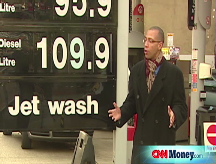Oil at 3-1/2 year low, below $47
Crude prices get pummeled by demand concerns in a floundering economy.
NEW YORK (CNNMoney.com) -- Oil prices continued falling on Tuesday, tumbling to 3-1/2 year low, as concern about the floundering global economy and falling demand again took center stage.
U.S. crude for January delivery fell $2.32 to settle at $46.96 a barrel. It was the lowest closing price since May 20, 2005, when oil settled at $46.80 a barrel.
A day earlier, oil prices plummeted more than $5 a barrel in the wake of a spate of gloomy economic reports.
"People are worried about their jobs, about their ability to pay for Christmas," said Tom Orr, head of research for brokerage Weeden & Co.
Slowing economy: Businesses and consumers in the United States, the world's largest oil consumer, have been under intense pressure.
High unemployment and potential collapse of the U.S. auto industry have led many to cut back on fuel use in spite of falling gasoline prices.
During the past four weeks, U.S. demand for gasoline has fallen to about 9 million barrels a day, down 2.8% from last year, according to the Energy Department. On Tuesday, motorist group AAA reported that gas prices fell for the 76th consecutive day to an average of $1.812 per gallon.
Stocks have also taken a pummeling, as the Dow Jones industrial average lost 7.7% on Monday.
"People are getting slaughtered in the market, and they're getting laid off left and right," said Orr.
Inventories: A government report scheduled for release on Wednesday is expected to show a 2 million barrel increase in U.S. crude inventories, according to analysts polled by financial information firm Platts.
Last week the report showed crude stockpiles had spiked higher than expected, and helped drive prices lower.
Weekly reports on energy inventories can naturally fluctuate from week to week as tankers are delayed, weather disrupts production, or other unforeseen events alter oil's import and production schedule. But if supplies continue to build, it could be another signal that U.S. crude use was dropping, according to Orr.
"If [Wednesday's] number doesn't balance out tomorrow, that could make people a little more nervous," said Orr.
OPEC: Investors have also been waiting to see what the Organization of Petroleum Exporting Countries will do when it meets on Dec. 17 to discuss crude prices, which have fallen more than 66% since hitting a record high of $147.27 in mid-July.
OPEC members produce about 40% of the world's oil and include major exporters such as Saudi Arabia and Venezuela. The decline in oil prices has prompted many OPEC members to advocate production cuts in order to keep prices from falling further.
Over the weekend, Saudi Arabia's King Abdullah said told a Kuwaiti newspaper that $75 a barrel is a fair price for crude.
At an unscheduled emergency meeting in Cairo this weekend to discuss falling prices, OPEC decided to wait until the December meeting to take action, thus refocusing investors onto declining demand.
"OPEC is really having trouble getting ahead of the curve and cutting production as consumption decreases," said James Williams, energy economist with analysis firm WTRG Economics in Arkansas.
Compliance: Many investors believe OPEC nations have been inconsistent in their compliance with the organization's October decision to take 1.5 million barrels a day off the market.
Some OPEC producers, seeing their oil profits slide due to falling prices, have been reluctant to cut production further, according to Williams.
"As the price drops, the incentive to cheat goes up," he said.
Saudi Arabia, OPEC's largest producer, said over the weekend that it hoped member nations would meet at least 80% of the goal. Many investors took that statement to mean OPEC had not yet reached its pledge, with some pegging compliance at as little as 60%, according to Orr.
The failure of member nations to fulfill their existing obligations may put the burden of a second production cut squarely on the shoulders of Saudi Arabia, he added. ![]()




